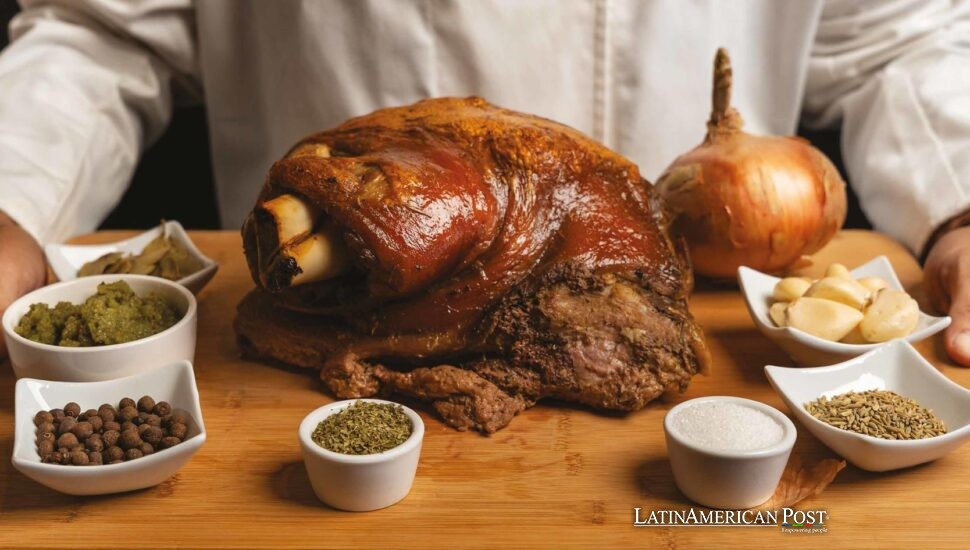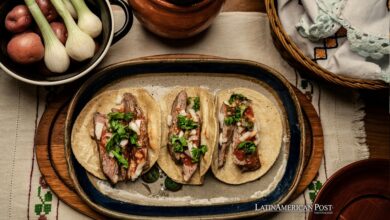Puerto Rican Grandmothers Stir Art and Flavor in Sofrito Manifesto

Artist Bernardo Medina raided his late abuela’s recipe shoebox and splashed those flavors across 250 pages of photographs and pop-art paintings. The Sofrito Manifesto is an equal parts cookbook and love letter, bottling Puerto Rico’s kitchen soul for a restless diaspora.
A Shoebox Unlocks the Island’s Hidden Pantry
The box wasn’t pretty—just a battered piece of cardboard shoved behind dusty Tupperware in a Bayamón cupboard—but it guarded a dynasty. Medina remembers his grandmother Emilia snapping it shut whenever little hands crept too close. Inside: onion-perfumed clippings from Reader’s Digest, grease-stained newspaper columns, recipe cards where every line curled like a ballroom dancer’s step. When the pandemic pinned him at home, boredom turned to pilgrimage. He and his sister Emily spread those slips across the dining-room table, each scrap a breadcrumb to family history.
Phone calls followed—one aunt in Caguas, a cousin in Kissimmee, a neighbor who remembered how Abu Inés coaxed cassava into airy almojábanas. Voices cracked, laughed, corrected memories. Fifty recipes survived the audit: Christmas-eve pasteles wrapped in plantain leaves, chicken gizzards braised for church bazaars, sofrito simmered until the whole house smelled like Saturday morning. “We realized,” Medina says, “that every dish was a telegram: ‘I love you, eat.'”
Turning Fritters Into Pop-Art Fireworks
According to an EFE report, Medina designed Caribbean music posters, borrowing Warhol’s neon swagger and splashing it across conga drums. A plain recipe collection would not do, so he built tiny movie sets for each plate. A tux-clad couple dissects a street-stall alcapurria beneath a crystal chandelier. Rellenos de papa freeze mid-air above a vintage fry pot, hot oil exploding in a slow-motion crown. Photographer Mariela Apollon captured crumbs floating like meteor showers; sculptor Marcos Irizarry rebuilt pastelón as a stacked Plexiglas skyscraper glowing from within.
Seventy photos, twenty art pieces, and bilingual captions overlap on the same spread—the layout mirrors island code-switching, with Spanish and English finishing each other’s sentences. Medina insists the food never vanishes beneath the spectacle. “You should be able to lick the page,” he laughs, and taste culantro.”
Grandmothers Who Seasoned the Future
Recipes alone do not explain why a bite of arroz con gandules can knock grown adults straight back to age seven. Emily fixes that gap with ten short stories printed in Spanish and shadowed in English, each a postcard from childhood: Bernardo filching tostones off a cooling rack; Abu Inés humming Trio Los Panchos boleros while the pilón thunders cilantro into submission. One line stops the reader cold: “Nobody cooks like your grandma because she cooks for your future.”
That sentence, Medina admits, made him set down a proof copy and cry in the print shop. “Abuela wasn’t feeding me in 1983,” he says. “She was feeding the adult I’d become.” Bilingual text ensures that the message travels—from San Juan apartments to Bronx walk-ups—wherever Puerto Ricans chase rent and weather reports from home. Coffee-table elegance meets countertop mess; more than one first run has already returned to the publisher splattered with annatto oil, a badge of proper use.
When A Manifesto Multiplies
Medina printed a modest batch and is expecting to gift it to friends. Instead, indie bookstores in Río Piedras sold out in a weekend; a Brooklyn pop-up moved sixty copies before noon. Publishers Weekly notes that pandemic-era readers crave objects they can smell and stain; The Sofrito Manifesto offers both. Momentum birthed a dessert sequel—tembleque wobbles under star-anise perfume—and a slim booklet of traditional rums and coffee liqueurs. Next year comes The Sofrito Soul, ninety chefs from San Juan to Orlando riffing on abuela canon. Early pages reveal Michelin-level mofongo plated like an abstract sculpture, a vegan longaniza nodding to diaspora diets. “Heritage and innovation,” Medina says, “aren’t rivals; they’re dance partners.”
He is also talking to schools. A charter school in Chicago wants to adapt the stories for bilingual literacy lessons, and a Miami culinary program hopes to stage a pop-up gallery where students cook the art. The dream loops back to that shoebox for Medina: ordinary women, undocumented geniuses of flame and fragrance, promoted to museum walls and glossy spreads.
Stirring The Diaspora’s Hunger and Pride
Flip through the finished book, and two sensations appear: hunger and recognition. Hungry because the photos coax saliva; recognition because somewhere in those images is every Puerto Rican kid who woke to garlic sizzling at 6 A.M. Medina’s manifesto argues food is more than comfort—it’s citizenship, especially for migrants toggling between salsa radio and English-language pay stubs.
In that sense, The Sofrito Manifesto joins a lineage of culinary declarations—The Joy of Cooking for middle-class America, Like Water for Chocolate for Mexican magical realism—but with a Caribbean wink. Pop-art hues insist Puerto Rican cuisine deserves the same iconic status as a Campbell’s soup can, while the trilingual text (Spanish, English, Spanglish) says the island’s voice cannot be hemmed in.
Also Read: Mexico’s Virgin of Guadalupe Lights Madrid and Bridges Centuries of Shared Faith
Print runs will sell and fade, but the project’s more resounding success lies in kitchens: a granddaughter in Hartford grabbing plantains because a page made her homesick; a grandson in Orlando realizing the pastelón he Instagrammed is also contemporary art. “Abuela fed the future,” Medina repeats. Thanks to his manifesto, that future now feeds itself—with sofrito, memory, and a splash of neon paint.

